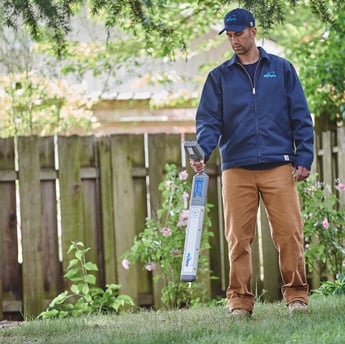Utility locators use a variety of equipment to perform their job. Locators decide which types of utility locating tools to use based on both the type of work being done and the kind of utility they are trying to locate. Reliable utility locating methods keep excavation crews and communities safe from hazardous utility strikes.
Utility locating is the process of finding and marking utility assets, such as sewer and gas lines, that are buried underground. There are different types of utility locating methods, all of which protect the public from disasters like gas line explosions or electrocution, which can occur if someone strikes a buried utility. In the United States, anyone planning on doing any kind of digging project is required to call their state’s 811 center prior to digging; these centers manage and implement locates for public utilities. And since most construction sites have at least one private utility, excavators are also responsible for hiring private locating services to locate all non-public assets on their dig sites.
Types of Utility Locating Equipment
There are three main types of utility locating equipment:
Ground penetrating radar (GPR) technology:
GPR is used for locating all kinds of buried utilities (conductive and non-conductive). Different types of utility locating equipment are usually made up of two parts, a transmitter and a receiver. In the case of ground penetrating radar, the transmitter emits radio waves into the ground. When these waves hit something underground, they reflect off of the object and are collected by the receiver. The receiver’s software translates these signals into an image of the object belowground.
Electromagnetic (EM) profiling locators:
EM locators are only used to locate conductive utilities. The equipment’s transmitter emits a specific electromagnetic frequency into the ground. Once this frequency is transmitted through a metallic utility, the receiver begins to identify and trace out the asset's location.
Radio frequency (RF) pipe and cable locators:
RF locators are also used to locate conductive utilities. Like EM equipment, a radio frequency locator uses high frequencies to identify buried assets, and its transmitter and receiver function in the same manner.
Which Type of Utility Locating Equipment Should I Use?
EM locators are the primary utility locating method, according to Benjamin Iles and Richard Byrne, GPRS’s northeast region area manager and eastern US video pipe inspection manager, respectively. Iles and Byrne note that GPRS’s locators use ground penetrating radar and electromagnetic scanning equipment on nearly every locating job. Although electromagnetic equipment is limited to locating metallic objects, it is faster, easier to operate and more accurate than ground penetrating equipment is. GPR, on the other hand, can locate both conductive and non-conductive materials, but it takes an experienced locator to accurately identify all of the different types of assets. Using GPR and EM tools together maximizes the potential of each and increases the likelihood that all underground utilities will be located fully and accurately.
Utility locators must also take environmental conditions into account when deciding which equipment to use. Qualities such as soil conductivity and soil moisture levels play a role in determining how well locating equipment can function. For example, GPR works best in sandy soils; in dense, clay soils its high-frequency waves can have difficulty penetrating the ground.
Developments in Utility Locating Methods
While the theories behind locating equipment have stayed the same for years, locating technology has experienced some advances. For example, when Byrne and Iles both started out in utility locating around ten years ago, they were drawing utilities out by hand on graph paper. Nowadays utility locators can use geographic information system (GIS) software to map out assets. And with budding technologies like drone imaging on the rise, the applications for utility locating will only continue to grow.
Understanding the symbols, colors and codes used to mark out underground utilities is essential for keeping dig sites safe. Our utility markings poster lists common symbols and abbreviations for you to master. Request your free copy today.


